
I don't know what climbing, specifically alpine climbing, means to anyone including myself. I can no more tell you why climbing is so important and good for me than I can tell you how the universe was created or what "life" is.
But I know it started as a dream, a wish for adventure and a ability to comprehend what I saw in nature as something more than just special.
No matter what I climb, the type of terrain or how much I enjoy the moment it is all related to being in the mountains eventually and alpine climbing.
I get teased sometimes about my obvious boot fetish. Couple of things happened recently to bring me back to the original "dream", cold feet and why my desire of wanting to climb so badly.
The boot fetish is based on the reality of spending a lot of time out doors as a young kid. My parents hunted, fished and skied. Of course all that slowed down when they had kids..at least until we (the kids) could walk. And by walking I don't think we had to be able to walk far before we were off on their adventures. From my childhood I remember three things from those adventures, cold feet, how I liked heights when everyone else got scared and how much fun it was to be in the snow.
So the boot fetish should be easy to understand. I had cold feet from day one!
In the late 1950's the lookout shown above was the first place I remember seeing, and others talking about, climbing. I can remember my Dad walking with me out to the lookout and back hand in hand on that set of stairs. I was in the 2nd grade. Imagine my surprise to find out the Needles had its, "first recorded technical climbing is April 1970, Fred Beckey, Dan McHale, Mike Heath climbed the South Face of the Warlock, an 8 pitch climb rated 5.9." That ascent is of course a a full ten years after me seeing climbers in the Needles.
The view of the Needles from the lookout.

That was 50 years ago and I still get a thrill remembering the journey. It was another 10 years before I was to actually climb. But not because of a lack of desire. As I aged I remembered the thrill of that simple visit to the Lookout and the awe I had for the guys climbing on the rocks.
Learning to ski held my attention as did dirt bikes, basketball, football, bicycles, guns, knives and swimming. In the late '60s and early '70s our high school library carried a French magazine called "Paris Match" and even though I was taking French I couldn't read much of it. But, my Oh my, the pictures! Rene Desmaison made me WANT to be a alpine climber. Add a subscription to National Geographic my Grandmother gave at Chrismas every year since I was born (really, since I was born) and how could I not WANT to climb :)
" Readers of Paris Match read his dramatic reports and a radio audience measured in millions shivered with him during a live broadcast caught in a storm on the north face of the Grandes Jorasses......
In the 1960s when many of the so-called “last great problems” in the Alps were being addressed, Desmaison played a leading part in solving them. One attempt on the unclimbed Central Pillar of Freney, high on the Brenva face of Mont Blanc, became a France v Britain race. A team including Chris Bonington, Ian Clough and Don Whillans had a day's lead and were attempting the difficult overhanging crux of the climb when a group led by Desmaison appeared, attempting the same pillar by a nearby line. Bonington recalled that the corner crack they were trying to climb was too wide for their pitons but too small for the protective wooden wedges they were carrying. A request to the French for suitable gear met a firm and not unreasonable “non”, as the same gear was needed on their own route. Bonington and Whillans persevered, overcame the crux and dropped a rope to the rest of their team which the French then asked to use to ascend the difficult pitches. The rope was left, but seemingly failed to find a mention in French accounts of the climb.
Desmaison's closest brush with death came in the winter of 1971 attempting a new route on the Grandes Jorasses. With Serge Gousseault, a newly qualified Chamonix guide, the two climbers became trapped by violent storms sweeping the mountain face. After six days of slow, difficult climbing the weather had closed in. They reached a summit cornice, an overhanging lip of snow and ice, only a short distance from safety but were unable to move, hanging from pitons in a festoon of ropes. Rescue helicopters twice arrived above them but failed to understand Desmaison's signals for help. On the 12th day Gousseault froze to death and it was two days later that Desmaison, near death himself from cold and dehydration, was air- lifted to safety. Two years later he returned and completed the climb, once more arriving on the summit in a storm. "
René Desmaison, French mountaineer, guide, author and film-maker, was born on April 14, 1930. He died on September 28, 2007, aged 77
So between Desmaison and Gaston Rebuffat, another French Alpinist with a penchant for photography, writing and good climbs I was hooked long before I ever owned an ice axe.
Skiing, when I started, most still used leather boots. And the boots could be used for walking as required as well as skiing. Not cutting edge technology by any means even then but a whole lot of fun. Not a lot of difference between skiers and climbers then from my limited perspective.
Then while in high school our family moved to a little town just east of Mt. Adams. From our new home you could see Mt Hood, Mt Adams, St Helens, and of course Mt Rainier!
Now I just had to learn how to climb mountains! Of course I had no clue just how much mountains and climbing would come to influence the rest of my life.
A duplicate of my first "climbing" boots, age 14. Army surplus, alpine troop, ski and mtn boot. Bought in Lewiston Idaho with paper route money shortly before seeing Mt. Hood up close for the first time.
That was my start. Yours?







 When setting up dynamo lighting on a bicycle with no provisions for it (i.e. no internal routing or special braze-ons), there is always the question of how to route the wiring so that it looks "clean." After all, no one likes to see black wires coiled around a frame's fork and tubes. When setting up the lights on my Rivendell some time ago, the Co-Habitant and I developed a nice method that is practically invisible, and I've been meaning to share it. So when we recently did the same to my Bella Ciao, I made sure to document it.
When setting up dynamo lighting on a bicycle with no provisions for it (i.e. no internal routing or special braze-ons), there is always the question of how to route the wiring so that it looks "clean." After all, no one likes to see black wires coiled around a frame's fork and tubes. When setting up the lights on my Rivendell some time ago, the Co-Habitant and I developed a nice method that is practically invisible, and I've been meaning to share it. So when we recently did the same to my Bella Ciao, I made sure to document it.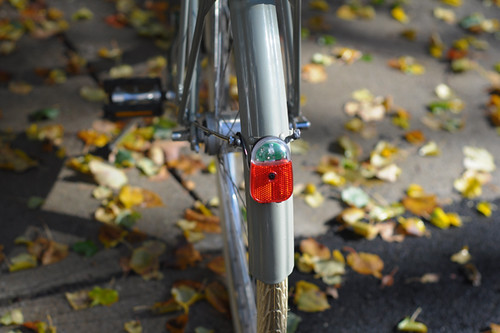 This method assumes that your bicycle is equipped with fenders, and that you are installing both a headlight and tail light. I will also assume that you already know how to connect the lights themselves; this is not meant to be an electrical tutorial.
This method assumes that your bicycle is equipped with fenders, and that you are installing both a headlight and tail light. I will also assume that you already know how to connect the lights themselves; this is not meant to be an electrical tutorial.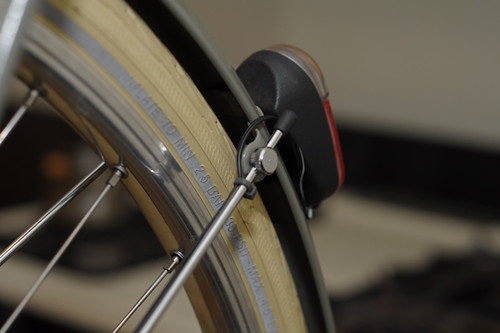 The key to our method is using as little wiring as necessary - running it in a straight line parallel to existing stays and tubes, as opposed to coiling it, and securing it with colour-matched zipties. It's a simple idea, but colour-matched zipties really do blend in with the bicycle when all is said and done. You may be surprised to learn that they are available in all sorts of colours - from bright rainbow hues, to neutrals such as clear, white, cream, taupe and gray. We use small gray zipties to route the wire from the tail light along the non-drivetrain side fender chainstay.
The key to our method is using as little wiring as necessary - running it in a straight line parallel to existing stays and tubes, as opposed to coiling it, and securing it with colour-matched zipties. It's a simple idea, but colour-matched zipties really do blend in with the bicycle when all is said and done. You may be surprised to learn that they are available in all sorts of colours - from bright rainbow hues, to neutrals such as clear, white, cream, taupe and gray. We use small gray zipties to route the wire from the tail light along the non-drivetrain side fender chainstay.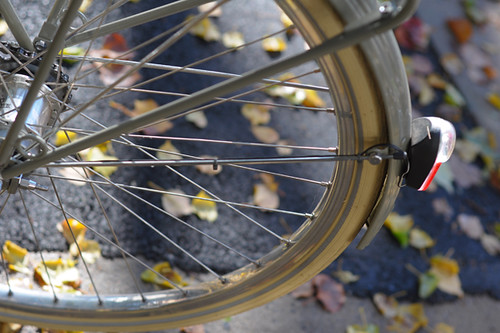 In natural light, the result looks like this.
In natural light, the result looks like this.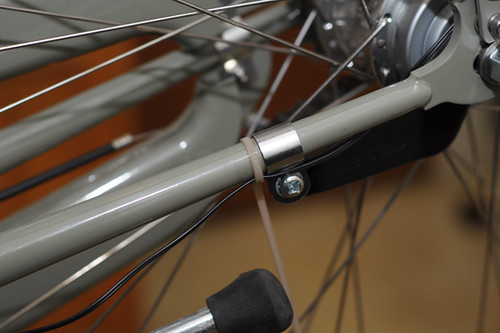 We then proceed along the non-drivetrain side chainstay, using a larger colour-matched ziptie. This frame is a sort of pale military green, and this beige ziptie blends in nicely.
We then proceed along the non-drivetrain side chainstay, using a larger colour-matched ziptie. This frame is a sort of pale military green, and this beige ziptie blends in nicely.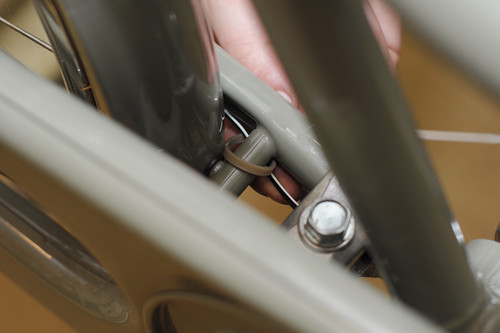 Continuing the same underneath the bottom bracket.
Continuing the same underneath the bottom bracket.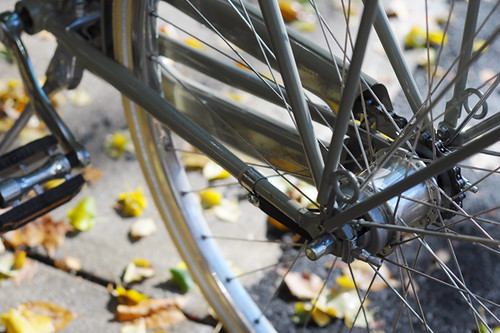 In natural light, the wiring really does "disappear" when routed in this manner, staying close to the chainstay.
In natural light, the wiring really does "disappear" when routed in this manner, staying close to the chainstay.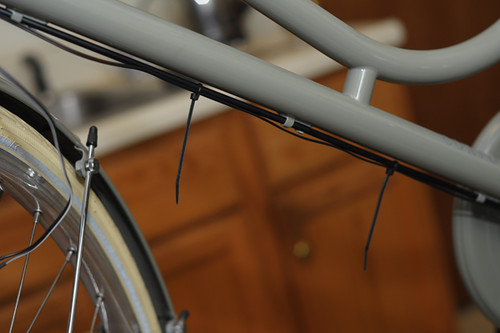 If your frame already has shifter cable braze-ons on the downtube as this one does, then you can simply attach the wiring to the shifter cable itself (small black zipties this time). Otherwise, use two large colour-matched zipties for the dwntube, like we did here.
If your frame already has shifter cable braze-ons on the downtube as this one does, then you can simply attach the wiring to the shifter cable itself (small black zipties this time). Otherwise, use two large colour-matched zipties for the dwntube, like we did here.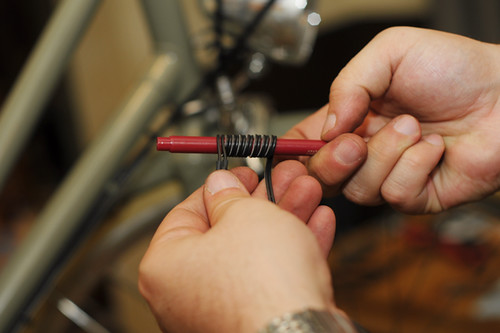 For the headlight, you will need to leave enough wire so that your ability to turn the handlebars is not constricted. We prefer to achieve this by creating a coil here. To do this, simply wrap the wire tightly around a pen or a stick.
For the headlight, you will need to leave enough wire so that your ability to turn the handlebars is not constricted. We prefer to achieve this by creating a coil here. To do this, simply wrap the wire tightly around a pen or a stick.  And voila, there is your coil. Notice the additional ziptie along the shifter cable, just to keep everything neatly in place.
And voila, there is your coil. Notice the additional ziptie along the shifter cable, just to keep everything neatly in place.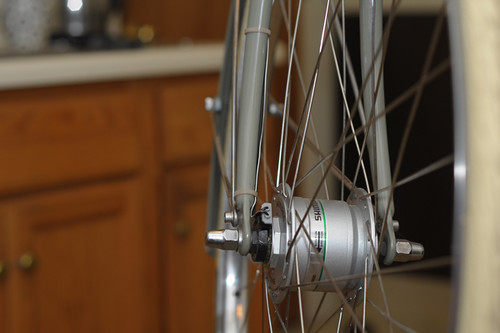 Finally, use the same colour-matched zipties along the fork as you did along the chainstays, routing the wire to the hub as tautly as possible.
Finally, use the same colour-matched zipties along the fork as you did along the chainstays, routing the wire to the hub as tautly as possible.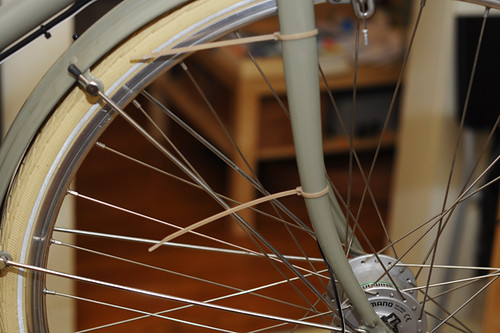 Even frames with internal routing often lack provisions for the fork, and here I find it especially important to find zipties in a colour that blends in with the paint - otherwise it can look as if the fork is cut into pieces, its elegant curvature disturbed. I am using my camera flash to show the process, but in daylight this really looks quite unobtrusive.
Even frames with internal routing often lack provisions for the fork, and here I find it especially important to find zipties in a colour that blends in with the paint - otherwise it can look as if the fork is cut into pieces, its elegant curvature disturbed. I am using my camera flash to show the process, but in daylight this really looks quite unobtrusive. In natural light up close.
In natural light up close.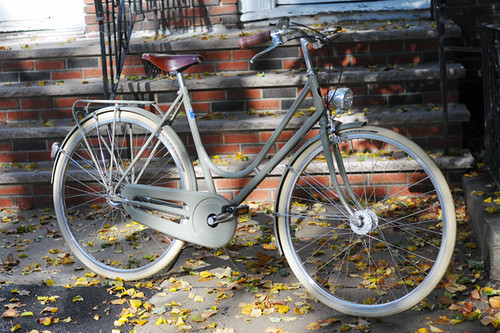 And from further away.
And from further away. 

 Last week, I revisited Camp Muir for the first time in three months. Things there seemed as normal as ever when it comes to spring access... However, things will be different this summer with the new guide services on the mountain. The most notable change will be that the NPS ranger station is moving to the Cook Shack (which is much more centrally located in camp). Also worth noting are the changes to what guide service will be operating out of what facility... AND that there will be a few new weatherports at Camp Muir... When the dust settles on the plan, I'll post more information. In the meantime, t
Last week, I revisited Camp Muir for the first time in three months. Things there seemed as normal as ever when it comes to spring access... However, things will be different this summer with the new guide services on the mountain. The most notable change will be that the NPS ranger station is moving to the Cook Shack (which is much more centrally located in camp). Also worth noting are the changes to what guide service will be operating out of what facility... AND that there will be a few new weatherports at Camp Muir... When the dust settles on the plan, I'll post more information. In the meantime, t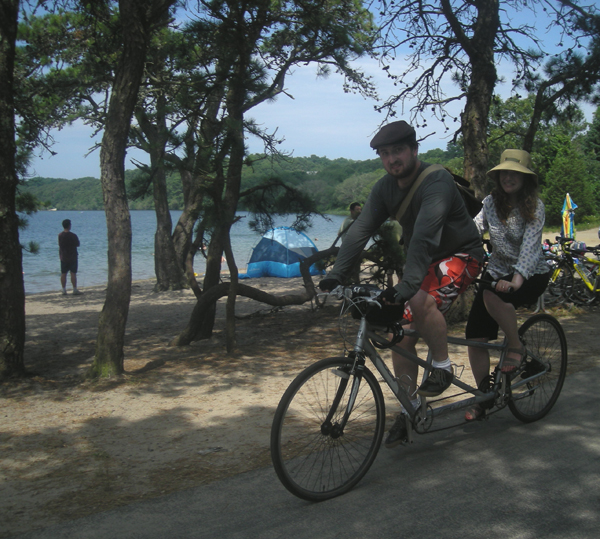 Over the weekend we wanted to take our bikes to Cape Cod and cycle on theRail Trail. Unfortunately, our lighter bikes are at the shop and the Pashleys are too heavy for the car's rear rack. Browsing the rail trail brochure, I noticed an advertisement for tandem rentals. Tandems! Within seconds, I was making a reservation.
Over the weekend we wanted to take our bikes to Cape Cod and cycle on theRail Trail. Unfortunately, our lighter bikes are at the shop and the Pashleys are too heavy for the car's rear rack. Browsing the rail trail brochure, I noticed an advertisement for tandem rentals. Tandems! Within seconds, I was making a reservation. The person at the front of a tandem is called the Captain, and the person in the back is the Stoker. The job of the Captain is to steer and balance the bicycle, and to control the gearing. The job of the Stoker is to provide extra leg-power on the pedals and maintain the balance.If you are the Stoker, the Captain's back will be your view (inches from your face), unless you turn to the side!
The person at the front of a tandem is called the Captain, and the person in the back is the Stoker. The job of the Captain is to steer and balance the bicycle, and to control the gearing. The job of the Stoker is to provide extra leg-power on the pedals and maintain the balance.If you are the Stoker, the Captain's back will be your view (inches from your face), unless you turn to the side! I could not, but I was a good Stoker!
I could not, but I was a good Stoker! Steve's glory from the summit (photo by Steve Machuga)
Steve's glory from the summit (photo by Steve Machuga) I was “home” again, and happy to be here!
I was “home” again, and happy to be here!
 "But, Mom! Warm, clean towels make such a nice bed."
"But, Mom! Warm, clean towels make such a nice bed."






